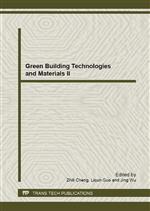Engineering Research
Materials Science
Engineering Series
Green Building Technologies and Materials II
Description:
Proceedings of the 2nd International Conference on Green Buildings Technologies and Materials (GBTM 2012) was held in Wuhan, China, December 27-28, 2012. GBTM 2012 is an annual international forum for dissemination of original ideas and research results in Green Building and Technologies and Materials in theoretical and practical aspects.
The papers are grouped as follows:
Chapter 1: Green Building Technologies;
Chapter 2: Green Building Materials and Structures;
Chapter 3: Urban Planning and Architectural Environment Engineering.
Purchase this book:
Info:
Review from Ringgold Inc., ProtoView:
The 116 papers were selected from over three times that many submissions, and cover green building technologies, green building materials and structures, and urban planning and architectural environmental engineering. Among the topics are the green management analysis of construction projects based on full life cycle, a green approach to a low-energy residential building design for a hot arid climate, integrating a ceramic solar collection system into a building's design, evaluating the embodied energy for building materials in Turkey, measures for coping with climate change in college campuses in Korea, cooperative environment planning strategy research in Hokkaido and Guangdong, and studying architectural patterns of a residential quarter based on atmospheric pollutant diffusion from a point source.

